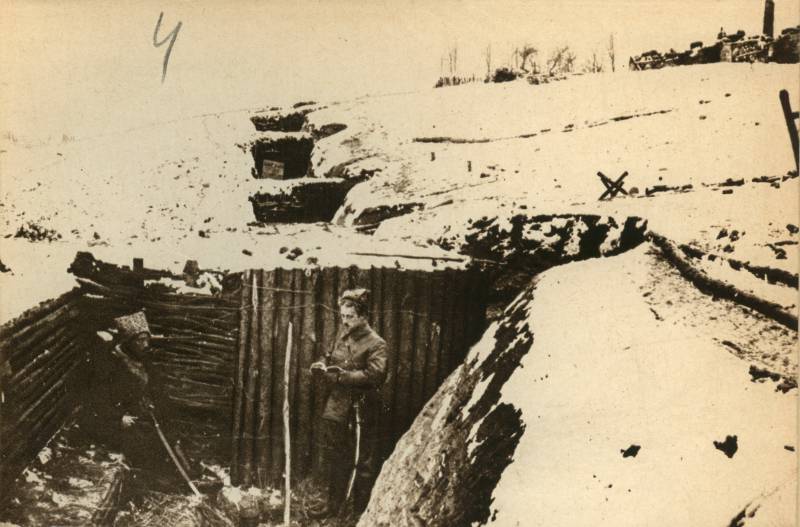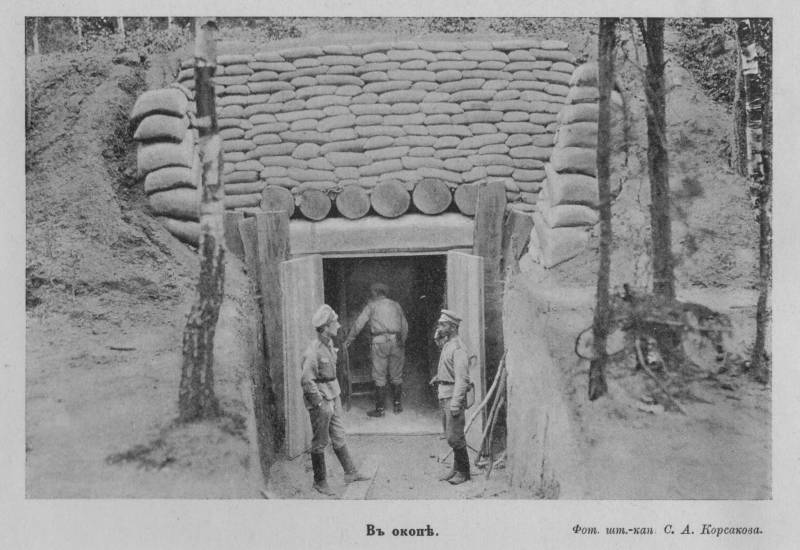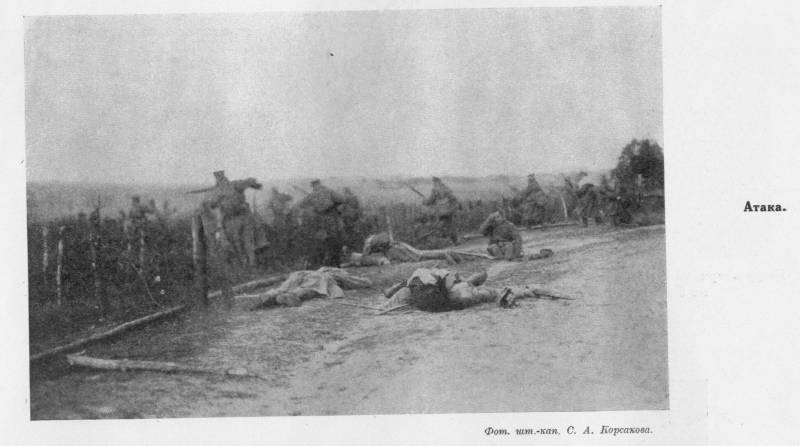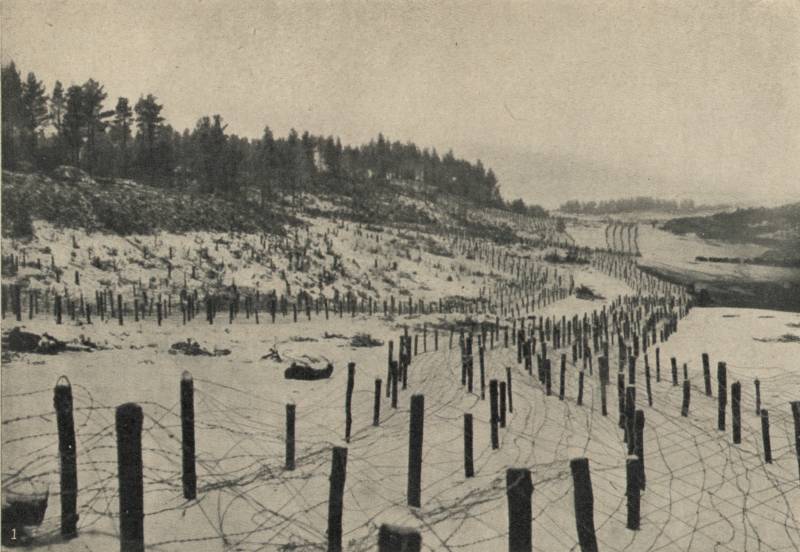Break through the wall without breaking a head. CH 1.
1. Russian trenches in Poland. It was in the autumn - winter of 1914 on the Russian front that the first (yet temporary) establishment of positional fronts took place.
The attack of a fortified position in a positional warfare was characterized by the following features that distinguish it from the offensive during a period of maneuverable combat operations.
1. Any offensive operation of this period was to capture not one, but to assault no less than 2-3 reinforced lanes - and the capture of each of them required serious and thorough preparation. Thus, the operation acquired a protracted and complex nature.
2. Mastering a single line of enemy trenches did not provide a tactical victory — the defender, pulling reserves to the next line, could counterattack to reject the attacker and reduce all his previous successes to zero. It is necessary to master the whole fortified strip. Accordingly, the assault on each defensive line could not be gradual - otherwise the enemy, using a pause, would restore the situation. Thus, this is a long (and at the same time energetic) process consisting of interconnected and carefully calculated stages.
3. During the assault, the attacker's troops suffer heavy losses, his units, located in enemy trenches and message moves, are mixed up - respectively, the management becomes much more complicated. Therefore, the part that made a breakthrough or stopped by enemy resistance before the capture of the entire fortified zone cannot be considered combat-ready. Moreover, the injection into this part of the reserves will not give anything - a new onslaught must be made in absolutely fresh parts. Weakened by the battle and frustrated regiments are required not to reinforce, but to replace, taking them to the reserve (and, if possible, to put in order, and to a deeper rear).
4. Accordingly, it is necessary to echelon the troops in depth and have strong reserves.
5. Attention artillery - the main tool of the attacker - forks. When fighting for fortified positions, artillery must work on two targets — manpower and defensive structures.
2. An indispensable attribute of the positional period of hostilities. Powerful dugout in a full profile trench.
The attack in the context of positional warfare was very difficult and risky, since: a) strong defenses of the defender required systematic artillery preparation, meticulous work of artillery and a large number of projectiles; b) strong and organized enemy fire required thorough engineering preparation of the attack and the creation of artificial approaches to enemy positions — to effectively overcome the sweep space; c) the development of the defense system on the front and in depth required a well-thought-out plan of attack, special training of troops, supply of infantry with strong escort artillery and a clear system of artillery training; d) a special role was assigned to aerial reconnaissance and fire adjustment; e) the concentration of a huge number of shells, guns, engineering property, etc. required a proper degree of development of communication routes - both for the transfer of reserves and for the ammunition supply of forces and means already brought into battle.
Moreover, the complex preparatory work unmasks the intentions of the attacker. Accordingly, the most important task was to carefully observe the secrets in preparing for the operation and the implementation of a whole complex of disguise measures. After all, it is enough for the defender, who promptly discovered the preparation of the offensive by the enemy, to bring in a sufficient amount of additional artillery in order to doom the attacker who lost the fire superiority of the offensive.
But sometimes the desire to keep secret the preparatory activities leads to other extremes - for example, the command of the Russian 7 Army, preparing the winter operation 1915 on the river. Strype, in order to maintain tactical surprise, forbade reconnaissance of enemy positions.
The too severe restriction of intelligence that took place in the winter operation 1915 on Stryp (7-I Army) and in the Naroch operation 1916 (2-I Army) was sometimes replaced by the ratio of a completely opposite order. Thus, during the period of the Baranovichi operation (4 Army) in May 1916, the Polish rifle division was put forward in the first line - and on the very first night several dozen people ran over to the side of the enemy - and gave the Germans valuable information about the upcoming Russian offensive.
The most important problem in a positional war was the question of the interaction of infantry with artillery. Combat experience has found that no artillery preparation is able to adequately pave the way for the advancing infantry, especially in conditions of an increased depth of defense. Therefore, the infantry had to operate as autonomously as possible, having in its combat formations escort artillery and trench guns, as well as devices for the destruction of man-made obstacles. For example, special scissors, axes, hand grenades and pyroxylin cartridges on special poles were used to lay the aisles in the wire obstacles. Existing regulations found it desirable to have 25-30 width passes on the basis of 3-4 passage to the battalion. The wolf pits were first thrown with bundles of brushwood or straw, and on top - bags of earth.
The infantry must be well trained in the fight against machine-gun nests, guns, resistance nodes, positions on reverse slopes, etc. If you had to overcome several lines of artificial obstacles, it was necessary to create intermediate lines connected to the rear through communications. Accordingly, it was recommended to include in the assault columns units, armed with hand grenades, shovels, axes, blasting agents. Attacked and detachments sapper. The teams of the “trench cleaners” were important - they had to clear the recaptured positions from the residual groups of enemy fighters. These teams were armed with hand grenades, revolvers, carbines, daggers and lances, and also supplied with pocket electric lanterns.
When storming enemy positions, it was recognized that it was necessary: 1) to achieve an advantage in fire, 2) to destroy artificial obstacles, 3) by successful maneuver through the achieved breakthroughs to go to the flank and rear of those sectors and combat groups of the enemy that are still holding.
But if the obstacles could not be neutralized, the offensive stopped, the troops dug in - additional machine guns and melee weapons were pulled up to the battle line, actions with handguns and rifle grenades began, and artillery resumed artillery preparation. But the effect of tactical surprise was lost - and the “gnawing” of the enemy’s defensive positions began.
Of particular importance in the conduct of an offensive battle in a positional war was the uninterrupted supply of the attacking units with ammunition and technical means, as well as the skillful handling of reserves. It was also important to correctly calculate the time needed to solve the tasks. After all, the offensive operation included a series of successive stages, at each of which the question of feeding the operation with reserves and ammunition was of lasting importance.
The troops assigned to the breakthrough and ensuring the use of the breakthrough are the strike or the breakthrough group, and the troops entering the breakthrough and intended to develop and use the breakthrough by striking the enemy’s flanks and rear are a maneuverable group.
But a breakthrough is only the first (albeit the most important) stage of an offensive operation in a positional war. Equally important were the stages of development of the breakthrough and consolidation of the occupied territory.
An offensive battle at the stage of positional warfare demanded increased tactical independence from soldiers, non-commissioned officers and officers.
Given the importance of the tactical surprise factor, it was necessary to minimize the duration of artillery preparation while maximizing its effectiveness. Timing and the presence of a clear system in the conduct of artillery fire were an important guarantee of success - the concentration of the guns of necessary calibers, the distribution of targets, the determination of the required volume of ammunition and careful reconnaissance of objects were of key importance. For example, it is important to point defeat defenses, but no less important and the shelling of the entire combat zone of the enemy - the enemy soldiers could hide from the shelling in random trenches, craters from shells, etc.
A significant circumstance for ensuring tactical surprise was the accelerated and secretive transfer, as well as high-quality disguise of fire weapons. It was taken into account that the artillery on a horse-drawn traction passes 60-70, and on a mechanical trap (“tractor artillery”) - 100-200 km per night. Proper subordination of artillery capacities was also important for the effectiveness of the offensive operation, also because the passages made in the wire barriers accurately indicated the enemy's direction of impact, and additional fire support was required for the infantry in such sectors.
Finally, the methodology of artillery preparation and infantry escort of infantry significantly influenced the effectiveness of the offensive operation. For example, the Germans formed a movable barrage of two elements - after heavy fire of heavy artillery, followed by a fire shaft of light artillery, followed by the advancing infantry. Combat experience has shown that when attacking a fortified position, the speed of the fire shaft should not exceed 1-1,5 km per hour, and at the same time move in jumps along 150-200 meters. Of particular importance was the fire of chemical ammunition. And the exact calculation of artillery was of paramount importance in a positional war.
3. Attack. Autumn 1914 East Prussia.
In the battle of the 2 Army Corps near Dobronouc, the firing area was a valley in 9 km along the front and 3,5 km in depth. It was necessary to take into account the enemy’s batteries, which are located to the right and to the left of the breakout area of 5 km - this was of paramount importance in the course of the struggle for fire superiority. T. o. the whole front of the fight for fire superiority was no less than 19 - 20 km. But the power of the enemy fortifications required the presence of large artillery forces - no less than 45 guns per 1 kilometer of the front of the attack, while the 9 army could allocate all 211 guns to this area. I had to find ways to do a big deal with small means - to solve the problem using the method of gradual transfer of fire. It was also necessary to fight the enemy’s artillery - on the firing range of 19 km, the Austrians had up to 100 guns, artillery of the 2 divisions. It was impossible to crush all these weapons. The task was solved by the Russian gunners as follows: first, the enemy’s observation posts, which had lost contact with their batteries, were crushed, so the batteries, which were south of the front of the attack, were inactive at the most important time. The fact that the Austrian batteries, which stood opposite the northern flank of the attack, were located in the ravines, was also taken into account. They were first defused with gases fired along the valley of the stream, and then finished off with chemical shells. T. o. fire superiority was achieved - despite the artillery power, which clearly did not meet the requirements of the problem to be solved.
Careful organization of fire fighting led to the fact that the attack was very successful - and on the very first day the infantry passed on 2 - 3 km into the depths of the enemy defense. In the future, the efforts of the artillery focused on actions against heights - and the corps gradually mastered them. This determined the final defeat of the Austrians.
4. These were such powerful defensive positions that the Russian army had to break through during positional hostilities.
A completely different situation took shape at the front of the 7 Army in December 1915. In the fight of the 2 Army Corps near Dobropol, the firing area was a height of about 8 km and a depth of 4 km - covering the entire valley of the r. Stryp. The organization of the battle required the presence of at least 300 guns - and there were only 150 of them. Attempts to attack the fortified position of the enemy on the front in 2 - 4 km without taking into account its batteries on the flanks of the breakthrough section (due to the lack of artillery support means) were invariably stopped by the flank fire of the Austrians.
The experience of the war on the Russian front proved the possibility, with the availability of airborne surveillance equipment, to conduct a successful battle with enemy artillery. This experience showed how coherence and interaction of artillery with aviation must be achieved in order to shoot 2 - 3 targets per hour (the norm of joint work of artillery and aviation). In Russian artillery, an artillery reconnaissance service was organized in 1916.
Of great importance was the area on which the batteries operated. So, in the 24 battle in May 1916, the terrain was commanded by the enemy. But the enemy occupied its base — and behind its trenches, the terrain for the length of 2 km rose to a height prepared for defense, but occupied only by reserves. Russian positions covered the location of the enemy arc. In this area, it was possible to identify the observation points of the enemy and the location of all of its 4 batteries covering the defense area. As a result, the Russian gunners managed to quickly achieve fire superiority, the enemy’s batteries and infantry were neutralized, and the Russian infantry carried out a complete breakthrough of the enemy’s front in a two-day battle. The situation was similar during the actions of the 80 Infantry Division in the Prut operation 1915.
In a positional war, quantitative superiority over enemy artillery was the most important guarantee of success. The French norm indicated that this requires the fire of 12 guns for 12-18 minutes at the positions of each identified enemy battery. Russian requirements were more modest - for a successful fight against the enemy's battery, it was considered sufficient to have 1,5 own batteries, i.e. Xnumx guns. In this case, for 9 - 15 minutes of work, the division will destroy the enemy's 20 batteries.
Because of the relative quantitative poverty of the Russian artillery, she was given the task of not destroying the enemy’s battery, but only neutralizing it. And for this it was enough and the 0,5 battery on the enemy's 1 battery - 2 projectile, falling every minute on the enemy battery, will not allow gunners to approach the guns.
And while 1 1 was attacked on the Somme on July 1916 400000 shells, or 8 thousand tons of metal (or 27 trains on 30 cars), the Russian troops spend 145 howitzer and 455 light shells on the Dobronouc breakout to train attacks, having in stock 280 howitzer and 380 light shells on the gun - only about 75000 shells.
Each order required careful expenditure of shells. Thus, the commander of the 6 heavy field artillery brigade, Colonel V.F. Kirey, writes an 21 order from 1916 in May: “I forbid shooting bursts”, “I forbid shooting and shooting with fans”. T. o. - each shot at the target, each shot - with the adjustment. The shells were distributed "in a teaspoon" to the gun, but each shell had to produce a certain effect.
Not only a small number of shells, but also the hard experience of 1915, when the artillery took up the position in order to detain the enemy, with only 15 - 20 shells on the battery - all this brought up the personnel of the Russian artillery in the spirit of austerity shells. In battles on Rotten Lime 1915, the 10 artilleryman tried it once, 10 once checked the correctness of his calculations - before releasing a projectile. The artilleryman was accustomed to choose the target tactically necessary, learned to distribute his unfortunate 15 shells, while still leaving some of them - “just in case”. In 1916, when the mobilized industry began to produce a fairly significant amount of products, strict discipline of artillery fire still prevailed at the front, and the personnel of the artillery already had the necessary tempering - based on the sad experience of 15. They began to look skeptical at methodical shooting, at the shelling of squares from the side of German artillery, with the consciousness of their own superiority — as unacceptable licentiousness. Each weapon was corrected, gunpowder and fuse marks were studied, 1000 and 1 methods were used - in order to spend the minimum amount of shells on a target. The expenditure of 10-ti shells to zero on one target was considered a disgrace. Artillery technician spent the day and spent the night on the batteries, continuously checking the guns. Shells cleaned, sorted, lubricated. We worked intensively on maps, checked them by aerial photographs. All this was done with the sole purpose - to reduce the consumption of projectiles.
But Russian artillery acted excellently and in such conditions - for all its poverty, it was distinguished by extraordinary flexibility and ability to solve difficult tasks with a very small amount of ammunition, with a lack of communication equipment, and with no centralized tactical leadership.
To be continued




Information